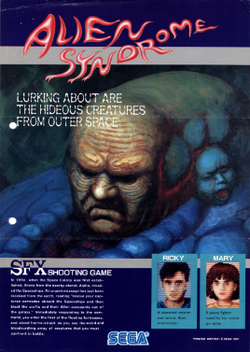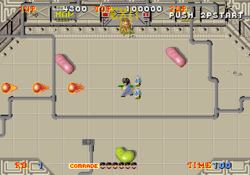Software:Alien Syndrome
| Alien Syndrome | |
|---|---|
 Arcade flyer | |
| Developer(s) | Sega Sanritsu (NES, Master System) |
| Publisher(s) | Sega |
| Composer(s) | Tohru Nakabayashi (arcade) David Whittaker (computers) Noboru Machida (NES) |
| Platform(s) | Arcade, Amiga, Atari ST, Commodore 64, Game Gear, MS-DOS, MSX, NES, Master System, ZX Spectrum, X68000, PlayStation 2, Xbox 360, PC, PlayStation 3 |
| Release | 1987: Arcade 1988: Master System, Amiga, Atari ST, C64, Famicom, MSX, NES 1989: Spectrum, MS-DOS 1992: Game Gear, X68000 |
| Genre(s) | Run and gun Horror |
| Mode(s) | Single-player, multiplayer |
| Arcade system | Sega Pre System 16 Sega System 16B |
Alien Syndrome (エイリアンシンドローム Eirian Shindorōmu) is a run and gun video game developed by Sega and released in arcades in 1987, and later ported to the Master System in 1988. The game utilizes a side-scrolling feature that allows the player to take control of either a male (Ricky) or female (Mary) soldier whilst hunting aliens and saving hostages before they run out of time.
Alien Syndrome released with a strong opening, becoming one of Sega's best-selling video games for the Master System. It received generally positive reviews, with praise towards the gameplay, character designs, sounds, and horror-themed gameplay. It was included as a bonus game in the Genesis compilation game, Sonic's Ultimate Genesis Collection (2009). A sequel of the same name was released in 2007 to a strong negative response from critics.
Gameplay
Two players control two soldiers, named Ricky and Mary, who fight their way through large eight-way scrolling levels while rescuing their comrades who are being held by aliens. After they have rescued a certain number of hostages, the exit opens and they can pass through it in order to fight the end-of-level guardian. If this monstrosity is defeated, they are then able to move onto the next stage. Alien Syndrome features two player simultaneous gameplay and pickups which assist the player, including better weapons and maps of the current level.
Ports
In 1988, the game was ported to the Master System, MSX, Amiga, Atari ST, Amstrad CPC, Commodore 64, and Famicom/Nintendo Entertainment System (published by Tengen without a Nintendo license). Later, the game was ported to the ZX Spectrum (1989), Game Gear (1992), and X68000 (1992).
Reception
In Japan, Game Machine listed Alien Syndrome on their May 15, 1987 issue as being the third most-successful table arcade unit of the month.[1] The original arcade version of the game was reviewed in the July 1987 issue of Computer and Video Games, where Clare Edgeley described it as "one of the most gripping games" she "played in months", praising the Aliens-like horror atmosphere, chilling sounds, special effects, graphics and gameplay. She stated it was "the first time the atmosphere and sheer addictiveness of a shoot 'em up has transported me to another planet" and concluded that it "is fantastic".[2]
The Master System version of the game was reviewed in Console XS magazine, giving it an 85% score.[3] It was reviewed in 1989 in Dragon, getting two out of five stars.[4]
Reviews
- Computer and Video Games (Apr, 1988)[5]
- Power Play (Feb, 1988)[6]
- The Games Machine (Mar, 1988)[7]
- Sega Power (Dec, 1993)[8]
- ACE (Advanced Computer Entertainment) (May, 1988)[9]
Legacy
The game was also converted to polygonal graphics for the PS2 as part of the Sega Ages re-release program and included in the US version of the Sega Classics Collection (it was removed from the European version to receive a lower age certificate). This version has updated controls, adding the use of both analog sticks, similar to that seen in Sheriff, Robotron and Smash TV. The original arcade game was also included as an unlockable in Sonic's Ultimate Genesis Collection.
A sequel of the same name, Alien Syndrome, was released for Wii and PSP on July 24, 2007.
References
- ↑ "Game Machine's Best Hit Games 25 - テーブル型TVゲーム機 (Table Videos)". Game Machine (Amusement Press, Inc.) (308): 21. 15 May 1987.
- ↑ "Alien Syndrome arcade game review". http://www.solvalou.com/subpage/arcade_reviews/21/16/alien_syndrome_review.html.
- ↑ "Software A-Z: Master System". Console XS (United Kingdom: Paragon Publishing) (1 (June/July 1992)): 137–47. 23 April 1992. https://archive.org/details/console-xs-01/page/137.
- ↑ Lesser, Hartley; Lesser, Patricia; Lesser, Kirk (January 1989). "The Role of Computers". Dragon (141): 72–78.
- ↑ "SDI review from Computer + Video Games 78 (Apr 1988) - Amiga Magazine Rack". http://amr.abime.net/review_34317.
- ↑ "Kultpower Archiv: Komplettscan Powerplay 3/1988". http://www.kultpower.de/archiv/heft_powerplay_1988-03_seite96.
- ↑ "The Games Machine Magazine Issue 04". https://archive.org/details/thegamesmachine-magazine-04/page/n54/mode/2up.
- ↑ "SegaPower - December 1993". https://retrocdn.net/images/a/a7/SegaPower_UK_49.pdf#page=130.
- ↑ "ACE Magazine Issue 08". May 1988. https://archive.org/details/ace-magazine-08/page/n62/mode/2up.
External links
- Alien Syndrome at Arcade-History
- Alien Syndrome at the Killer List of Videogames
- Alien Syndrome at MobyGames
- Alien Syndrome at SpectrumComputing.co.uk
 |


